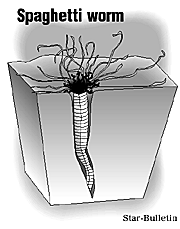Published in the Ocean Watch column, Honolulu Star-Advertiser © Susan Scott
January 19, 1998
A Hawaii reader writes via e-mail: “Hope you can help me. Twice in the last few months, I have seen a strange sea creature, once while snorkeling and yesterday while investigating tide pools. It looks like several strands of filament, the color of fishing line, but larger. The strands, about 12 to 24 inches long, all come from a central body that is hidden in the coral. The strands wiggle as though they might be searching for something.”
They are – they’re searching for food.
 These strands you describe so well are the feeding tentacles of marine creatures aptly named spaghetti worms. Like earthworms, spaghetti worms’ bodies are segmented.
These strands you describe so well are the feeding tentacles of marine creatures aptly named spaghetti worms. Like earthworms, spaghetti worms’ bodies are segmented.
They can grow up to 12 inches long with feeding tentacles reaching 3 feet long.
Spaghetti worms build elaborate tubes for themselves, either in sediment or in crevices between rocks.
The worm secretes its own “cement” from glands on its belly, then lines its tube home with coarse sand and shell fragments. Little hooks along the sides of the worm grip the walls of the burrow and securely anchor the body inside.
Once snuggled down, the worm sends out feeding tentacles which constantly search the ocean floor for just about anything dead, dying or deposited there.
The moveable tentacles bear tiny hairlike structures along their surface and are able to curl up on themselves to form a groove.
When a tentacle finds something to eat, it forms such a groove and beats its tiny hairs, thus moving the food to the mouth. Sometimes a tentacle lassoes the food and drags it to the mouth, where the worm’s lips wipe the tentacle clean.
IF you come across a spaghetti worm, you can watch these amazing tentacles in action. Gently touch one, and the worm will withdraw all its tentacles back into its body. Wait a moment, and they will gradually creep back out to resume feeding.
Hawaii hosts 11 species of these interesting reef cleaners; five of these are found nowhere else in the world.
Although most of the spaghetti worm tentacles I’ve seen in Hawaii are bluish-white, they also come in pink and purple.
One of the more common species of Hawaii’s spaghetti worms shares its tube home with a tiny crab.
Such sharing of living quarters is common among several kinds of tube worms since their tubes provide protected, well-ventilated hideaways. Other guests include other worms, bivalves and crustaceans.
On the southeast coast of the U.S., a giant tube worm with a body 3 feet long hosts no less than eight other animal types in its tube. This creature bears the appropriate name of the maitre d’ worm.
Ancient Hawaiians called spaghetti worms kauna’oa or kio and used them as medicine (for what ailment is not clear).
Patients either drank an infusion of cooked tentacles daily for several weeks or sucked the body fluid from a live worm through a bamboo tube.